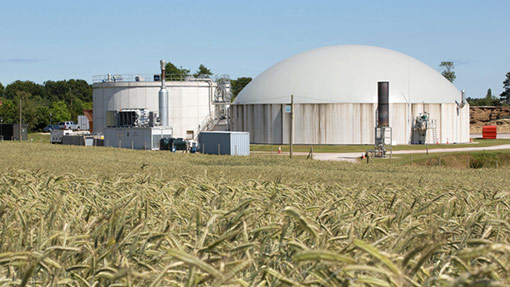Put thought into AD silage storage and handling

Bad design and poor silage clamp management can be costly in anaerobic digestion (AD) operations.
“While you can change and upgrade the technology in your AD plant, your silage clamps are a more permanent fixture and should be given just as much thought,” said Will Wilson of clamp manufacturer Bock UK.
Speaking at a KWS open day, he ran through key criteria for clamp construction:
See also: Small-scale AD stalls as Feed-in Tarrifs cuts bite
Storage options
Four silage clamp and storage options are commonly used in the UK for silage fed to AD plants. Field clamps are simple but can get contaminated with stones and soil.
Bagged systems and permanent concrete clamps – with either vertical or sloping sides – are the common choice.
Each has its benefits and drawbacks – concrete clamps, for example, will last a long time but require a higher initial financial outlay.
Environmental issues
The Silage, Slurry and Agricultural Fuel Oil regulations are key. You must inform the Environment Agency (EA) that you’re constructing a silage clamp 14 days before you start, but you should engage well before you begin as the EA has the power to stop you if there are concerns over leachate from silage contaminating groundwater.
Have your drainage plan to hand too – if something happens do you know where your drains are and where they run to?
Positioning and design
There are several crucial things to consider – feed-out rates, direction, positioning and the base. Keep the clamps narrow and the silage face to a minimum.
Try not to point the clamp into a prevailing wind as it forces oxygen into the silage face, aerating the clamp and undoing the good compaction work you’ve done.
Consider an asphalt base – it’s quick, relatively cheap and can be replaced much easier than concrete if it wears – but make sure your supplier is used to agricultural requirements as it mustn’t contain any limestone, which will react with the leachate.
Ultimately, it’s a question of choosing a site for the clamp with the next 20 years in mind – shoehorning it into a corner near the AD plant may seem like a good idea but bad design will cost you a lot more in the long run.
Filling clamps with gas in mind
Better compaction means better silage and a higher gas yield. As a rule of thumb your compaction machinery should weigh one-third of what you have going into the clamp an hour. So if you’re filling at 100t/hour you should have 30t rolling it to achieve maximum compaction.
Cover the clamp as soon as possible with a good-quality sheet and bird-proof netting, which will also weigh the covers down.
